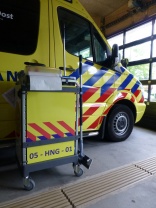Home › magazine › latest news › Ambulance cleaning room for improvement
Ambulance cleaning - room for improvement
10th of October 2016Paul Harleman, business development manager Benefrance at Vileda Professional writes exclusively for ECJ about the cleaning and disinfection issues ambulance services are facing. He looks at how they organise the cleaning process today and makes suggestions as to how they can improve.
Some time ago ECJ published news about a leading Dutch ambulance service in Amsterdam that had been given a final warning by the nation’s healthcare inspectorate because of their poor cleaning regimes and poor cleaning equipment. That is pretty serious I would say. The thing is, it is probably not a unique case. For instance, an investigation by the trade union UNISON found large variations in cleaning practices at ambulance trusts in the UK. And for sure there are other ambulance services in Europe with plenty of room to improve.
This article is about the cleaning and disinfection issues ambulance services are facing, how they organise the cleaning process today and suggestions as to how they could improve.
From car to high tech vehicle
The first known hospital base ambulance service dates from 1865 and was situated in Cincinnati (USA). In those days an ambulance was nothing more than a carriage drawn by horses. At the beginning of the 19th century car ambulances arrived on the scene. It was more or less a normal station wagon with very limited medical equipment.
Today technology has created high tech ambulance cars fully equipped with the latest medical instruments. And it is not only cars anymore, but also ambulance services with helicopters, motor cycles, bikes and boats.
There are basically three types of ambulances: emergency ambulance, transport ambulance and the rapid responder. The first two carry patients, the third does not. A rapid responder can be a small car or a motorbike. It provides elementary first aid at the accident scene.
Although the trend is to build ambulance interiors that are easy to clean, the actual interiors are still a nightmare from a cleaning point of view. The ‘ambulance world’ is moving on, which will have consequences for cleaning as well. More and more advanced equipment, ‘patient friendly’ interior design and higher demands on cleaning and disinfection will have an impact on cleaning requirements.
Do it, feel it, know it.
To be able to develop a concept for ambulance cleaning it is very important to start with the cleaning experience yourself. So at Vileda we contacted an ambulance service and cleaned ambulances ourselves. Together with the employees of the ambulance service. “Do it, feel it, know it”, that’s my motto. Talk and walk with the ones that normally do the job. That is often the most effective way to learn and to understand.
And indeed it was. We discovered many interesting things that could be improved. And the ambulance service personnel became more and more enthusiastic during the project. Now, let’s zoom in on the issues we found and the solutions we developed.
What makes it a challenge?
First of all, a typical situation is that the driver and the paramedic have to clean the ambulance. They are not trained professional cleaners. They also can have a motivation issue because drivers and paramedics consider it not to be a part of their job, but an unavoidable “must do”. Exactly the same situation you can observe with operation theatre assistants that sometimes have to clean in between surgeries. “We did not study for years to do the cleaning after an operation” is what I regularly hear from them.
Once you go in the ambulance there is the stretcher, one or two chairs, closets, a computer and several sets of medical equipment. It is a small room with many objects. All together a landscape full of edges, ridges, difficult-to-reach areas and many dirt traps. Typical dirt on the floor is of course street dirt. You would also expect blood contamination but that is rarely the case. The bleeding has been stopped on the scene of the accident.
However, what can happen is heavily traumatised patients throw up. Last but not least you have to realise that especially ‘in-between cleaning’ of an ambulance can have a time limitation. Ambulances don’t wait until the cleaning is finished when there is an emergency call. They turn on the lights and are instantly on the move.
Cleaning concept
Once you know the critical points a cleaning concept can be developed. What to clean and disinfect after every trip and what to do periodically. How to do it and what tools are needed to do it. Cleaning equipment, chemicals, machines, hygiene protocols - everything should be included in the concept.
In general a summary of the guidelines to clean an ambulance are:
• Don’t use a whole range of chemicals. Reduce it to a set that is really needed.
• Use as little detergent as possible. Plain water and a 100 per cent microfibre cloth is in many cases good enough.
• If you have to use a detergent, take care to dose correctly. Overdosing can cause smears and biofilms.
• Only disinfect when necessary. An Infection prevention expert can help to make protocols.
• Use microfibre cleaning mops and cloths, preferably disposable.
• Use a cleaning trolley. It is better to have all the materials you need on a trolley and take them to the ambulance than walking back and forth between the ambulance and the storage room where cleaning equipment is kept.
• Take care that all the touch points are cleaned and, if necessary, disinfected. Don’t forget the driver’s cabin and the hand grips on the outside of the vehicle.
• Put clean sheets and blankets on the stretcher after the ambulance is cleaned. An ‘open door’, but we saw the opposite as well. Often a matter of habits.
• Always check if a patient is contaminated with a contagious virus or bacteria that can be harmful. Like MRSA or Clostridium difficile. If it is known, follow the protocol.
• Take care that the people who clean the ambulance are trained and give them refreshment trainings periodically.









